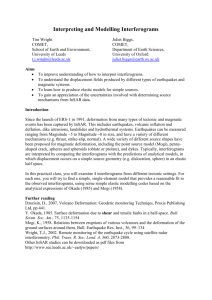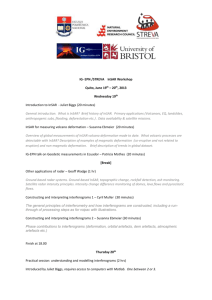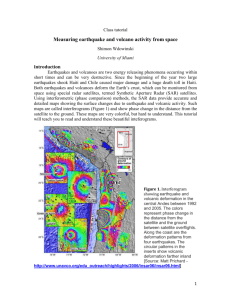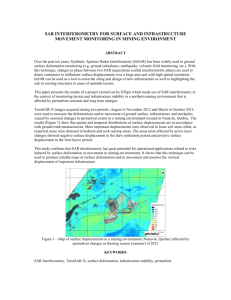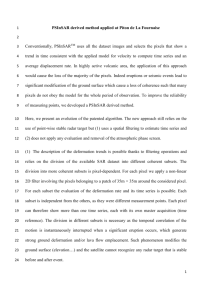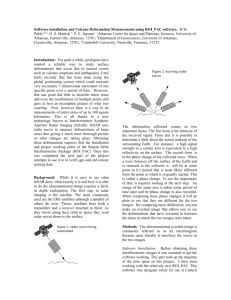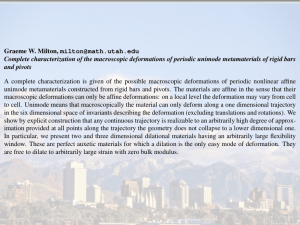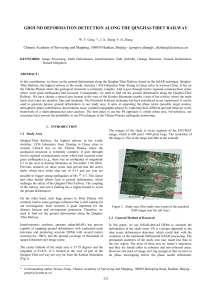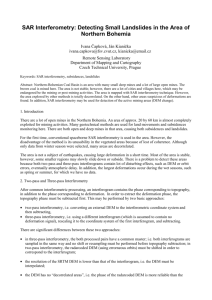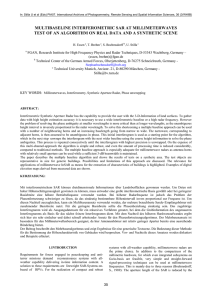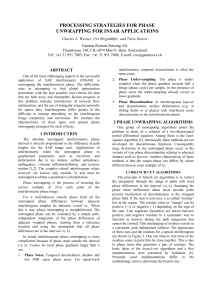DEFORMATION MONITORING BY MEANS OF SAR INTERFEROMETRY IN THE NORTH-BOHEMIAN AREA
advertisement
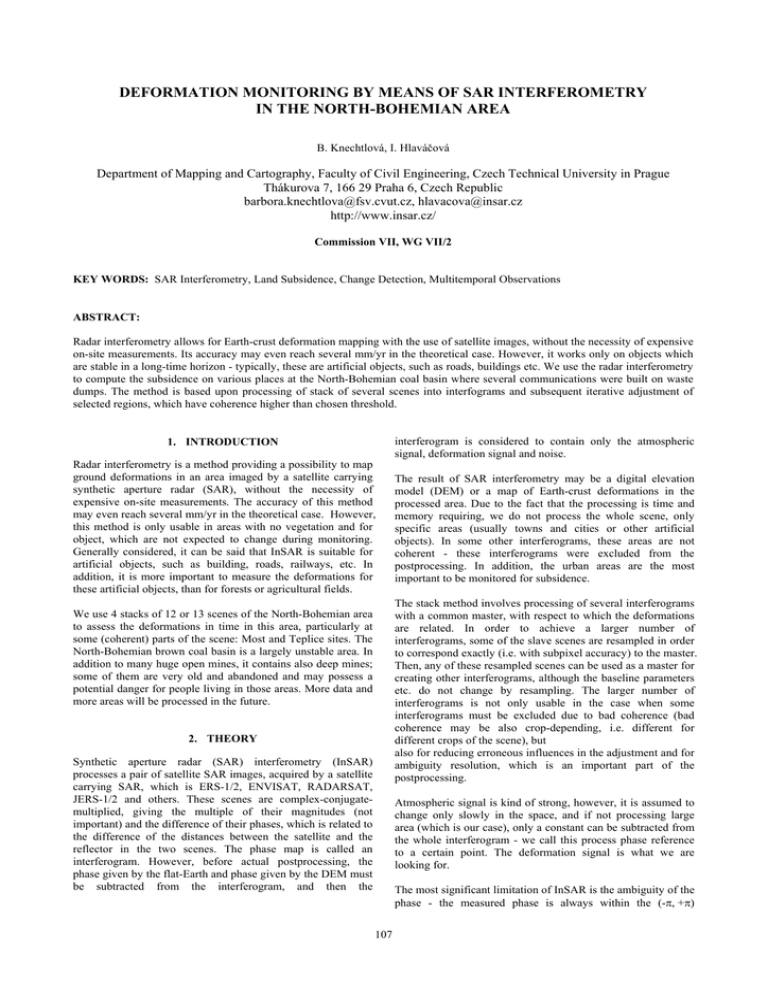
DEFORMATION MONITORING BY MEANS OF SAR INTERFEROMETRY IN THE NORTH-BOHEMIAN AREA B. Knechtlová, I. Hlaváčová Department of Mapping and Cartography, Faculty of Civil Engineering, Czech Technical University in Prague Thákurova 7, 166 29 Praha 6, Czech Republic barbora.knechtlova@fsv.cvut.cz, hlavacova@insar.cz http://www.insar.cz/ Commission VII, WG VII/2 KEY WORDS: SAR Interferometry, Land Subsidence, Change Detection, Multitemporal Observations ABSTRACT: Radar interferometry allows for Earth-crust deformation mapping with the use of satellite images, without the necessity of expensive on-site measurements. Its accuracy may even reach several mm/yr in the theoretical case. However, it works only on objects which are stable in a long-time horizon - typically, these are artificial objects, such as roads, buildings etc. We use the radar interferometry to compute the subsidence on various places at the North-Bohemian coal basin where several communications were built on waste dumps. The method is based upon processing of stack of several scenes into interfograms and subsequent iterative adjustment of selected regions, which have coherence higher than chosen threshold. 1. INTRODUCTION Radar interferometry is a method providing a possibility to map ground deformations in an area imaged by a satellite carrying synthetic aperture radar (SAR), without the necessity of expensive on-site measurements. The accuracy of this method may even reach several mm/yr in the theoretical case. However, this method is only usable in areas with no vegetation and for object, which are not expected to change during monitoring. Generally considered, it can be said that InSAR is suitable for artificial objects, such as building, roads, railways, etc. In addition, it is more important to measure the deformations for these artificial objects, than for forests or agricultural fields. interferogram is considered to contain only the atmospheric signal, deformation signal and noise. The result of SAR interferometry may be a digital elevation model (DEM) or a map of Earth-crust deformations in the processed area. Due to the fact that the processing is time and memory requiring, we do not process the whole scene, only specific areas (usually towns and cities or other artificial objects). In some other interferograms, these areas are not coherent - these interferograms were excluded from the postprocessing. In addition, the urban areas are the most important to be monitored for subsidence. The stack method involves processing of several interferograms with a common master, with respect to which the deformations are related. In order to achieve a larger number of interferograms, some of the slave scenes are resampled in order to correspond exactly (i.e. with subpixel accuracy) to the master. Then, any of these resampled scenes can be used as a master for creating other interferograms, although the baseline parameters etc. do not change by resampling. The larger number of interferograms is not only usable in the case when some interferograms must be excluded due to bad coherence (bad coherence may be also crop-depending, i.e. different for different crops of the scene), but also for reducing erroneous influences in the adjustment and for ambiguity resolution, which is an important part of the postprocessing. We use 4 stacks of 12 or 13 scenes of the North-Bohemian area to assess the deformations in time in this area, particularly at some (coherent) parts of the scene: Most and Teplice sites. The North-Bohemian brown coal basin is a largely unstable area. In addition to many huge open mines, it contains also deep mines; some of them are very old and abandoned and may possess a potential danger for people living in those areas. More data and more areas will be processed in the future. 2. THEORY Synthetic aperture radar (SAR) interferometry (InSAR) processes a pair of satellite SAR images, acquired by a satellite carrying SAR, which is ERS-1/2, ENVISAT, RADARSAT, JERS-1/2 and others. These scenes are complex-conjugatemultiplied, giving the multiple of their magnitudes (not important) and the difference of their phases, which is related to the difference of the distances between the satellite and the reflector in the two scenes. The phase map is called an interferogram. However, before actual postprocessing, the phase given by the flat-Earth and phase given by the DEM must be subtracted from the interferogram, and then the Atmospheric signal is kind of strong, however, it is assumed to change only slowly in the space, and if not processing large area (which is our case), only a constant can be subtracted from the whole interferogram - we call this process phase reference to a certain point. The deformation signal is what we are looking for. The most significant limitation of InSAR is the ambiguity of the phase - the measured phase is always within the (-π, +π) 107 The International Archives of the Photogrammetry, Remote Sensing and Spatial Information Sciences. Vol. XXXVII. Part B7. Beijing 2008 interval; however, the multiple of 2π to be added to the measured phase is never known. The step where the phase is converted from the ambiguous interval to the unambiguous real number is called phase unwrapping. Classically, this is performed in 2D array of the interferogram and the criterion is set for the unwrapped interferogram to have as little phase jumps (more than 2π difference between the neighbouring pixels) as possible. However, this criterion is set artificially and the result may be unreliable, especially in low-coherent areas (where the phase value is also considered unreliable). In order to make the phase unwrapping unambiguous at least in ideal cases, the assumption of spatial phase continuity is adapted. It means that the phase difference between two neighbouring pixels is in the (-π, +π) interval. In our case the assumption is helped by the fact that the interferogram contains only deformation signal (and noise). The points, where the assumption is not fulfilled, can be easily found out and are called residues. Between individual residues, branch cuts are created and the unwrapping paths are not allowed to cross them. Branch cuts creation is an ambiguous problem and its solution is not trivial. Several methods are applied for this problem, some of them even use different information, such as weights (coherence), scene magnitude (possible layover effects when unwrapping topography data) etc. When the area to be unwrapped contains low-coherent regions, which causes the rest of the area to break up into separated regions, only one of this regions is unwrapped (the one that contains the reference point, at which the unwrapping starts). We propose a method suitable for processing of stack of data where phase unwrapping errors are estimated iteratively in the third dimension - time. The method is described in section 4. 3. DATA SETS We focus on the North-Bohemian brown coal basin where mining has been performed for several centuries, using different mining methods. In past, lots of deep mines were opened however, these areas are expected not to subside any more. Currently, most coal is being mined using open-pit mines, which are then mostly recultivated to forests, lakes, agricultural fields etc. First step to be performed is referencing each interferogram to a single point, which is ideally stable. This step is performed to eliminate a large part of the atmospheric influence, together with other systematic errors which may originate e.g. from orbit errors. The reference point is ideally as close to the area of interest as possible and should be stable, because of relative nature of interferometric measurements. However, there are some areas where an artificial object was built on a waste dump, such that the well-known Ervěnice corridor (between Most and Chomutov), or the road between the villages Košťany and Mstišov (near Teplice). We decided to map deformations in these two areas using InSAR. The following processing is performed for each point individually, starting at the reference point and when selecting the following point, the point that has the most already processed neighbouring points is selected. Interferograms doubles and triples are constructed. In these cycles, the phase sum must be close to zero [1](Usai, 2004). This is one of the criteria for the iterative adjustment - the other is the unique standard deviation, which is required to be as small as possible. The interferograms, for which the sum is larger than a threshold, are then excluded (for the particular point). The phase sum is first computed using complex multiplication, i.e. the unwrapping errors are not counted for in this step. The unwrapping errors are then estimated from the neighbouring points (the unwrapping errors are assumed to change slowly in the space). For the first point, zero unwrapping errors are assumed (this is the unwrapping seed and the reference point so the phases are zero or close to zero here). Figure 1. Area of interest in North Bohemia For processing data acquired by ERS-1 and ERS-2 satellites during 1996-2000 are used. Due to bad coherence in the most areas, only parts of the scene is processed and analysed, namely roads built up on a waste dump, where the coherence is high enough to give predicative results. Then, adjustment is performed, modelling that each interferogram is a difference of two scenes. The aim of the adjustment is to estimate the phases of the scene, which can be directly computed into deformations. After the initial adjustment, the residues are checked and if any of them is larger than ±π the phase is corrected by an appropriate multiple of 2π (only one residue at a time). While the unique standard deviation is getting lower, this process is continued. When all residues are smaller than ±π or the unique standard deviation is higher, the phase sums in cycles are checked (now also considering unwrapping errors). If the cycle conditions are filled, the adjustment is finished for the point. If not, the space of ambiguities is searched for the best solution; however, it is not possible to search the whole ambiguity space because of its size - the search is limited to about 1000 searches, and the 4. ITERATIVE ADJUSTMENT We generate as many interferograms as possible from the available data. That means each scene is paired with each other, with previous resampling all scenes to a selected master. Then, after the topography is subtracted and the interferograms are spatially filtered and unwrapped, the most coherent points are selected from the interferograms (most of them are contained in the object we are monitoring) and then the most coherent interferograms are selected, which enter further processing (about 100). 108 The International Archives of the Photogrammetry, Remote Sensing and Spatial Information Sciences. Vol. XXXVII. Part B7. Beijing 2008 information from the unfilled cycle conditions is used. If the ambiguity search improved the solution, it is used as the starting point for a new iteration. However, due to a number of measurements excluded during the check process, it may happen that a scene is totally excluded, i.e. all interferograms containing a particular scene are excluded, making it impossible to compute the deformation for the particular scene for the point. This must be counted for when creating the adjustment matrices. Unfortunately, in-situ measured data are not yet available for comparison. Currently, we only try to reach the spatial continuousness of the results, which would mean that unwrapping errors, which are large in some areas, are corrected by the iterative adjustment. The spatial continuousness is partial, with some points having a deformation jump. Two statistical tests are implemented: Kolmogorov-Smirnov test for checking if the data set has normal distribution (it tests the standard deviation as well as the normality of the residues) and Snedecorov-Fischer test for testing the standard deviation. 5. RESULTS So far we do not have a proper way to display the results. We intend to use a GIS-software to easily visualise both spatial deformation between two time points as well as deformation of a single point in a time series. Figure 3. Deformations in Košťany area computed for time interval between 1997-07-21 and 1998-04-27 Figure 4. Colour scale, -150 mm on the left border, +150 mm on the right border • • Figure 2. Deformations in Ervěnice corridor computed for time interval between 1997-03-03 and 1997-09-29 In figure 2 deformations in the area of Ervěnice corridor are displayed and figure 3 contains visualisation of deformations in Košťany area. As can be seen in both figures, the results heavily depend on the coherence of processed area. Regarding this parameter, Košťany area shows better results (it is spatially continuous and probably stable). In case of Ervěnice corridor, a problem occurred that the reference point was not stable, so that the results cannot be interpreted straight away. However, the idea of referencing the phase with regard to one point is correct. What is not correct is the phase of the reference point, and although its precision is improved using the average of the neighbouring points, there still remains a large error (in addition, the average of the wrapped phase is ambiguous). 6. CONCLUSIONS AND FUTURE WORK Using InSAR method for land subsidence and monitoring of other types of deformation seems to be promising to give reasonable results in the future. However, it is very much influenced by the coherence of processed area. That is closely connected with the problem of spatial continuousness, which affects the algorithm based on neighbouring points. Even finding a stable reference point is very difficult, for in many cases no stable points are located near the processed area or are separated from the examined area by an area of low coherence. The first figure of the triple displays the deformation of all processed points, the second one contains points validated using the Kolmogorov-Smirnov test and the last one contains points validated using the Fischer test. The scale is imaged in figure 4, with -150 mm on the left and 150 mm on the right. 109 The International Archives of the Photogrammetry, Remote Sensing and Spatial Information Sciences. Vol. XXXVII. Part B7. Beijing 2008 Institute for Earth-Oriented Space Research, Delft University of Technology, the Netherlands. Next task for future work is to find an improvement for the algorithm, which would deal better with the estimation of referencing errors. REFERNECES Better results would be probably also achieved in connection with other measurements, such as GPS measurements or the method of Permanent Scatterers. Berardino, P., Fornaro, G., Lanari, R., Sansosti, E., 2002. A new algorithm for surface deformation monitoring based on small baseline differential SAR interferograms. IEEE Transactions on Geoscience and Remote Sensing, 40(11): 23752383. It would be very helpful as well to estimate the influence of the atmosphere after adjustment and to eliminate it before further processing even if the atmospheric influence is expected to be relatively small. Hanssen, R. F., 2001. Radar interferometry: Data Interpretation and Error Analysis. Kluwer Academic Publishers, Dordrecht. Hlaváčová, I., 2008. Interferometric stacks in partially coherent areas. Ph.D. Thesis. CTU Prague ACKNOWLEDGEMENTS The data were provided by ESA within project 3423: Repeatpass interferometry used for landslide and land subsidence detection in the undermined area and in the area with open brown coal mines. We have been using the orbits of the Delft Usai, S., 2004. A Least Squares Databsase Approach for SAR Interferometric Data. IEEE Transaction on Geoscience and Remote Sensing, vol. 41, No. 4. 110
